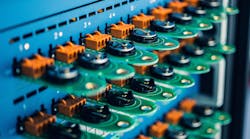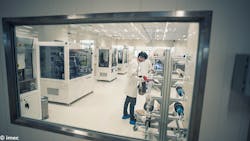Imec Doubles the Energy Density of its Solid-State Batteries
With today’s rechargeable battery technology reaching the physical limits of what conventional lithium-ion and lithium-polymer designs can do, researchers are being forced to look elsewhere to significantly improve the range of electric vehicles (EVs).
Solid-state batteries are an emerging option. Believed to be capable of higher energy density (2.5X), faster charging, and more charge/discharge cycles, solid-state batteries are promising candidates for resolving the intrinsic drawbacks of current lithium-ion batteries, such as electrolyte leakage, flammability, and limited energy density.
The major benefits of solid-state battery technology comes from the use of solid electrodes and a solid electrolyte instead of the liquid or polymer electrolytes found in lithium-ion or lithium-polymer batteries.
At the recently concluded European Electric Vehicle Batteries Summit (June 17-19, Berlin) Imec announced a solid-state Li-metal battery cell with an energy density of 400 Wh/liter at a charging speed of 0.5C (two hours), claimed to be a record combination for a solid-state battery. By way of review, charge and discharge rates of a battery are governed by C-rates. The capacity of a battery is commonly rated at 1C, meaning that a fully charged battery rated at 1 Ah should provide 1 A for one hour.
The solid nanocomposite electrolyte that the Belgian R&D center developed has an exceptionally high conductivity of up to 10 millisiemens/cm (mS/cm), with a potential, the researchers said, for even higher conductivities. A key feature of the new material is that it’s applied as a liquid via wet chemical coating. Only afterwards is it converted into a solid when already in place in the electrodes. That way, it’s well-suited to be casted into dense powder electrodes where it fills all cavities and makes maximum contact, just like a liquid electrolyte.
Using a solid nanocomposite electrolyte in combination with a standard lithium-iron-phosphate (LFP) cathode and lithium metal anode, Imec managed to double the results reported last year. It continues to follow its roadmap to reach densities over 1,000 Wh/liter at a charging speed of 2-3C (less than half an hour) by 2024.
Fabricating at EnergyVille
In addition, Imec announced that it has developed a pilot line for fabrication of solid-state cells at the EnergyVille Campus (EnergyVille is a collaboration between the Flemish research partners KU Leuven, VITO, Imec and the University of Hasselt in the field of sustainable energy) and was set up in Genk, Belgium jointly with the University of Hasselt. The pilot line allows manufacturing of prototype cells of up to 5-Ah capacity (see figure).
A pilot line for solid state battery cell production set up by Imec and the University of Hasselt at the EnergyVille campus in Genk, Belgium. (Source: Imec)
The facility includes a 300-m2 battery-assembly pilot line with a dry room of 100 m2 (the manufacture of lithium-ion batteries requires some processing steps to be carried out in a dry room, where the moisture content remains below 100 parts per million; the design and operation of such a dry room adds to the battery’s cost).
The conventional A4 sheet-to-sheet wet-coating-based line is said to be well-suited for processing of the solid electrolyte. As such, the assembly of the new cells could be done by slight modification of existing manufacturing lines for Li-ion batteries, which means the new technology would not need expensive investments to switch from wet to solid-state cells.
“The new battery demonstrates that our breakthrough electrolyte can be integrated in performing batteries,” said Philippe Vereecken, Scientific Director at Imec/EnergyVille. “The pilot line allows us to take the next step and upscale the battery breakthrough to industrially relevant processes and formats, using manufacturing processes similar to those for wet batteries.”


